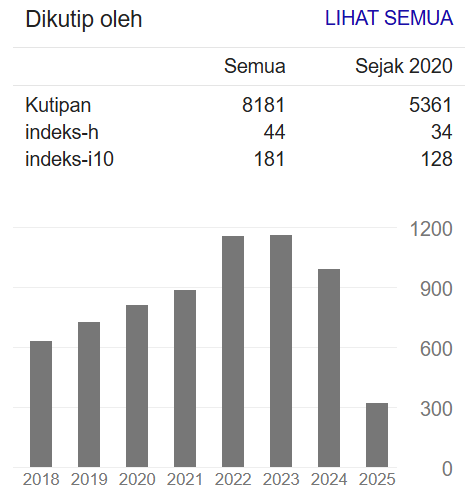DAYA HAMBAT DARI EKSTRAK SARANG BURUNG WALET PADA PERTUMBUHAN BAKTERI STREPTOCOCCUS MUTANS DAN PORPHYROMONAS GINGIVALIS
DOI:
https://doi.org/10.34011/jmp2k.v34i1.1790Keywords:
Porphyromonas gingivalis, Streptococcus mutans, Swallow's nest extractAbstract
Type 2 diabetes (T2DM) is one of the fastest growing global diseases of the 21st century, with its prevalence more than tripling in the last 20 years and affecting 10.5% of the world's population aged 20-79 years. In Indonesia, diabetes mellitus among 20-79 year olds is 10.6%. The most widely cultivated type of swallow nest is Collocatia fuciphaga. Collocatia fuciphaga is a species of bird that produces nests from its white saliva. Swallow's nest contains sialic acid which is only produced from saliva, calcium, glycoproteins and Epidermal Growth Factor (EGF), one of the benefits of which is to accelerate wound healing. The study aimed to determine the inhibition of swallow's nest extract on the growth of Streptococcus mutans and Porphyromonas gingivalis bacteria. The swallow's nest extract test used an experimental design approach, namely conducting laboratory tests. The initial stage was to make swallow's nest extract by maceration technique using 96% ethanol solvent (the aim is to get anti-bacterial active substances, namely D-Galactose and Sialic acid contained in swallow's nest), the result of the extraction was a dry extract weighing 1.8195 grams which was then dissolved again using DMSO solution with concentrations of 10%, 20%, and 30%. The second stage is the swallow's nest extract test with the two test bacteria. The results of the swallow's nest extract test at concentrations of 10%, 20%, 30% against Streptococcus mutans and Porphyromonas gingivalis bacteria showed no inhibition. Future research could be further developed toward wound healing
References
International Diabetes Federation, “International Diabetes Federation Atlas 2021 _ IDF Diabetes Atlas,” IDF oDiabetes Atlas 2021. pp. 1–4, 2021.
H. P. Nugraheni, “Direktorat Jenderal Pelayanan Kesehatan,” Kementerian Kesehatan RI. 2022.
C. Serón et al., “Diabetes, periodontitis, and cardiovascular disease: towards equity in diabetes care,” Front. Public Heal., vol. 11, no. December, pp. 1–7, 2023, doi: 10.3389/fpubh.2023.1270557.
W. Darajati et al., Indonesia Biodiversity Strategi and Action Plan 2015-2020. Kementerian Perencanaan Pembangunan Nasional/BAPPENAS, 2016. [Online]. Available: https://www.researchgate.net/publication/307628498_Indonesian_Biodiversity_Strategy_and_Action_Plan_2015-2020
A. Haris, “Efektivitas Krim Ekstrak Sarang Burung Walet Terhadap Penyembuhan Luka Mencit Di Kota Bima,” J. Anal. Med. Biosains, vol. 6, no. 2, p. 120, 2019, doi: 10.32807/jambs.v6i2.150.
F. Nuroini and N. Wijayanti, “Uji Efek Antiinflamasi Ekstrak Akuosa Sarang Burung Walet (Collocalia fuciphaga Thunberg) terhadap Gambaran Histologis Telapak Kaki Mencit ((Mus musculus Linneaus),” J. Labora Med., vol. 1, no. 1, pp. 21–26, 2017.
Ika, “Sarang Walet Berkhasiat Sembuhkan Luka Rongga Mulut,” Universitas Gadjah Mada, 2015. https://ugm.ac.id/id/berita/10183-sarang-walet-berkhasiat-sembuhkan-luka-rongga-mulut/
C. U. P. Umar, “Uji Ekstrak Sarang Burung Walet Collocalia fuciphaga Menggunakan Pelarut Metanol dalam Menghambat Pertumbuhan Propionibacterium acnes dan Candida albicans,” Universtas Hasanuddin, 2017.
A. Rifqi, “Aktivitas Antioksidan Ekstrak Air Sarang Burung Walet ( Collocalia fuciphaga ) dengan Metode DPPH (2,2-Difenil-1-1-Pikrihidrazil),” Universitas Islam Negeri Syarif Hidayatullah Jakarta, 2017. [Online]. Available: https://repository.uinjkt.ac.id/dspace/bitstream/123456789/37323/1/AHMAD RIFQI-FKIK.pdf
M. E. Dewi, “Benefits of Edible Bird Nest Consumption,” J. Kedokt. Ibnu Nafis, vol. 9, no. 1, pp. 12–16, 2020.
L. Elfita, “Analisis Profil Protein dan Asam Amino Sarang Burung Walet (Collocalia fuchiphaga) Asal Painan,” J. Sains Farm. Klin., vol. 1, no. 1, p. 27, 2015, doi: 10.29208/jsfk.2014.1.1.22.
H. Yulika, “Pola Resistensi Bakteri yang Diisolasi dari bangsal bedah Rumah Sakit Umum Pusat Nasional Cipto Mangunkusumo pada Tahun 2003 – 2006.,” Universitas Indonesia, 2009. [Online]. Available: https://lib.ui.ac.id/detail?id=123049&lokasi=lokal
P. Hasanuddin and S. Salnus, “Uji Bioaktivitas Minyak Cengkeh (Syzygium aromaticum) Terhadap Pertumbuhan Bakteri Streptococcus mutans Penyebab Karier Gigi,” Bioma J. Biol. Makassar, vol. 5, no. 2, pp. 241–250, 2020.
L. Reyes, “Porphyromonas gingivalis,” Trends Microbiol., vol. 29, no. 4, pp. 376–377, 2021, doi: 10.1016/j.tim.2021.01.010.
Fanny, “Morfologi dan taksonomi Streptococcus sanguis Streptococcus,” Gastron. ecuatoriana y Tur. local., vol. 1, no. 69, pp. 5–24, 2019.
D. Anggraini and L. Y. Kasmawati, “Formulasi Gel Sarang Burung Walet Putih (Aerodramus fushipagus) dan Uji Penyembuhan Luka Bakar Derajat II pada Mencit,” J. Sains Farm. Klin., vol. 4, no. 1, p. 55, 2017, doi: 10.29208/jsfk.2017.4.1.172.
C. Sanghajanna, “Efektivitas Ekstrak Apel Manalagi (Malus sylvestris Mill) Terhadap Pertumbuhan Bakteri Aggregatibacter actinomycetemcomitans,” Universitas Muhammadiyah Semarang, 2020. [Online]. Available: http://repository.unimus.ac.id/4013/
O. A. Hanafiah, T. Abidin, S. Ilyas, M. Nainggolan, and E. Syamsudin, “Wound healing activity of binahong (Anredera cordifolia (Ten.) Steenis) leaves extract towards NIH-3T3 fibroblast cells,” J. Int. Dent. Med. Res., vol. 12, no. 3, pp. 854–858, 2019.
I. W. Iskandar, “Uji Antimikroba Sarang Burung Walet Collocalia fuciphaga Thunberg. Menggunakan Pelarut Etanol dalam Menghambat Pertumbunan Propionibacterium acnes DAN Candida albicans,” Universitas Hasanuddin, 2018.




